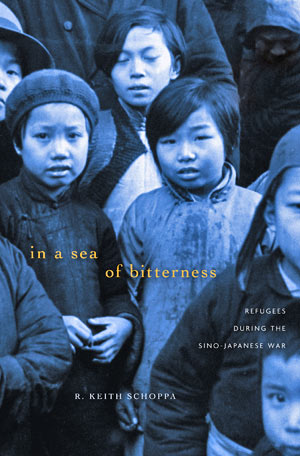
In a Sea of Bitterness is a narrative-rich study of spatial and social displacement during the Sino-Japanese War of 1937-1945.
I describe an array of Chinese people and institutions that chose to leave their homes and home bases when the Japanese first attacked and then occupied those areas. To give as much coverage to the range of displaced refugees and their experiences as possible, I have limited the spatial arena to Zhejiang Province, a coastal province on the East China Sea south of Shanghai.
The “range” of the displaced includes those who fled alone and with family members; these refugees fled their homes for varying distance and duration. Other displaced in the war were Chinese civilians kidnapped by the Japanese to serve in labor battalions. Others displaced included those whose lives were drastically affected by the Chinese government’s scorched earth policies and those forced to flee cities when the Japanese conducted bacteriological warfare, dropping bubonic plague-infested material and giving rise to plague epidemics. Displaced institutions included the provincial and county governments, schools (both private and public), businesses, and industries.
In addition, there are chapters detailing the general nature of displacement and the efforts of government and non-governmental organizations to deal with what was a refugee flight that became a tsunami. Zhejiang is the smallest Chinese province, but five million long-distance refugees came to it or passed through it.
This is an examination of the social and cultural impacts of war, a war in which the Japanese used deliberate tactics of terror with the hope that it would demoralize the Chinese and lead to a rapid surrender. Except for the chapter on Chinese commandeered for labor service by the Japanese army, my eye is completely on Chinese. Why did they flee—in a culture that particularly emphasized “native place,” the traditional family home where ancestors had lived, died, and were buried and which had a tremendous cultural force in people’s lives?
Another key cultural aspect raised frightening questions for refugees or would-be refugees. China was a “connection” driven and shaped society. When fleeing, the refugees had to leave these quintessential connections behind and go into territories where they had no connections. What kinds of experiences did they face on their flights at the hands of the “Other,” their own countrymen? What unique problems and trials did displaced institutions face? Throughout, I focus on Chinese citizens’ actions and reactions in the context of Chinese culture and social patterns as they experienced displacement.
I want the reader to be pulled into the nightmare world of the refugee by narratives, some based upon diaries, memoirs, newspapers, and official records. I provide statistics of numbers of refugees and how much government aid was used to help remedy their plight. But it their own stories and accounts that make the war come alive in all its disruption, ferocity, terror, and sadness.
One of the most desperate decisions people in any culture must make in the wake of war, ethnic cleansing, epidemic, or famine is to flee their homes and become refugees. Yet hundreds of thousands of people choose that option (or are forced to) almost every year, as has been recently evident in Sudan, Lebanon, and Iraq. The United Nations High Commissioner on Refugees noted in June 2006 that the numbers of uprooted peoples living in “refugee-like situations” in their home countries totaled 20.8 million, an increase of 1.3 million over 2005.
The refugee crisis is an ongoing tragedy that continually calls for policy decisions on how to provide life-sustaining assistance most effectively. Anthropologist Anthony Oliver Smith calls forced migration and resettlement “totalizing phenomena” that are always painful and almost inevitably produce a sense of powerlessness and alienation. Refugees have lost their world and their social identity. My book relates to these realities of displacement.
But the book is also posited on the idea that there are no “generic” refugees. Rather, the decisions of the displaced—whether to flee, where to go, and how long to stay away from native place—are rooted in their own cultural and social realities. It follows that in dealing with the lives of the displaced, their social and cultural undergirdings must be considered before policies to deal with them are instituted.
My professional path to this book was my interest in localities, their historical actors, and the workings of Chinese society and culture. And two of my previous books led the way.
Xiang Lake—Nine Centuries of Chinese Life (republished as Song Full of Tears) analyzed the communities around a lake (which functioned as an irrigation reservoir) from the early twelfth century to the mid-1980s. It focused on lake culture and social relationships of elites and non-elites and on the ongoing struggle over the centuries between wealthy developers and farmers dependent on the lake for their crops.
I wrote Blood Road: The Mystery of Shen Dingyi in Revolutionary China as a murder mystery, trying to solve Shen’s 1928 assassination, which was never solved. The process of writing this book plunged me into questions of identity, social connections, and contingencies—all of which are crucial issues in the lives of the displaced.
In the recent past, I developed an interest in the Sino-Japanese War, having dealt with many war-related issues in a course that I teach on the America’s Vietnam War (called the “American War” in Vietnam). All of these realities in my own research and teaching led me to this study of those displaced in various ways by war.
If a browsing reader picked up a copy of the book, I would hope that the Introduction entitled “The Thousand-Person Pit” would hook him or her. An account of an atrocity at a small town near the provincial capital (Hangzhou), this short chapter in many ways previews some later chapters. We see Japanese terror and Chinese responses through the eyes of one Chinese family.
If the browsing reader passed the Introduction, I would then hope that he or she would go to Chapter 3, “Veering into the Ravine.” This is a fascinatingly detailed memoir by Feng Zikai, a renowned graphic artist, cartoonist, and essayist who went on his refugee trek with thirteen of his family and friends. Feng’s account relates how refugees were treated (mostly mistreated and taken advantage of) by their fellow Chinese and how refugees became totally dependent for their decisions on rumors they heard as they trudged ahead—many of those rumors being false.
If the browser brushed past Chapter 3, I would urge him or her to go to Chapter 5, “The Kidnapping of Chinese Civilians,” the account of forced labor conscription by the Japanese army. It details the experiences of two men (one really a high school student) whom the Japanese seized to do their bidding. The chapter shows how not all Japanese were, in the phrase the Chinese used at the time, “foreign devils.” The Japanese in this chapter cannot be stereotyped in such blanket fashion, even though the use of terror remained their constant weapon.
But if the browser also did not stop at Chapter 5, I would push him or her up to Chapter 7, “Playing Hide-and-Seek with the Enemy.” This is basically the story of two county magistrates with their governments-in-exile situated in a third county—both of whom, in the process of becoming friends, had to dodge Japanese soldiers repeatedly. Their narratives are some of the most fascinating in the book; one ends tragically, killed by Japanese soldiers.
There are two other chapters that I would like the browser to get to first, if he or she has passed all those I have mentioned.
Chapter 10, “Scorched Earth,” tackles the insanity of a terrorized government moved to destroy its own infrastructure (most built in the decade preceding the war) far beyond what was necessary to stop the Japanese. And, in the end, it only slowed them down a bit—a tragedy of the first order.
The last chapter, “Bubonic Bombs,” is the tragic story of how three counties were affected by the Japanese-dropped plague and, most importantly, how they reacted to the challenges of this war crime. Their reactions and the developing policies depended in large part on how “modernized” they had become.
The foremost goal of the book is to give readers a profound understanding of the world of Chinese refugees at this time and place. Its focus on one province provides one solid context for the upsetting trauma of displacement, where everything seemed to be in flux in a world turned upside-down. How do the Chinese react when all ties to their key cultural and social foundations are severed or severely tested?
Historians have spent considerable time discussing the emergence and role of nationalism in modern China. Certainly among certain groups—students, political and economic elites in certain sites, especially cities—nationalism was developing from the early twentieth century on. One analysis (now almost fifty years old) posited that nationalism was born among the north China peasantry during the war when Japan attacked and occupied China. My study, however, shows that there was precious little overt nationalism or patriotic fervor. Instead, as war came, individuals and families—whether they fled or not—desperately strove to spread a protective mantle over themselves, saving themselves, their families, and their native places. The local, not the national, became the focus.
The war was a “localizing” phenomenon. Even refugee accounts (like that of intellectual Feng Zikai) are remarkable for their lack of nationalistic rhetoric. One diarist, as another example, did not say about the Japanese, “The devils brutally occupied China or my country”; instead he said repeatedly, “The devils brutally occupied my native place.”
Most of the refugees seemed to think that the Chinese army was as much a threat to the Chinese people as the Japanese army, commandeering its own soldiers, taking advantage in many ways of the Chinese populace, setting up roadblocks to steal from refugees—even storming into people’s homes to make their own meals.
This study suggests that among the masses, national feeling was incipient, at best. I suggest that for the masses, nationalism would not fully emerge until the 1980s and 1990s, when national pride could finally overcome the foreign and domestic humiliations that had been suffered for decades.
I would hope the reader would see, as one scholar put it, “Displacement is not just about loss of place, but also about the struggle to make a place in the world, where meaningful actions and shared understanding is possible.”
On the whole, the institutions that fled more successfully made new temporary places in the world (sometimes with immense difficulties) than did individual or family refugees. The foremost tragedy for many refugees as individuals or in families was, as in the case of Feng Zikai, that they returned to their native place only to find their homes completely destroyed by bombs or by another in Japan’s arsenal of war tactics, arson. Feng, experiencing the cultural bereavement that so many refugees had to deal with, noted on his return to his native town in 1946, “For the past decade my memories of my native place had sustained my wanderer’s dream, but the town I now encountered had nothing to do with the homeland I once held so dear. What I saw made me realize that it is far better to savor the dream of what once was.” The war brought to these people permanent displacement.


R. Keith Schoppa is the Edward and Catherine Doehler Chair in Asian History at Loyola University Maryland. Besides In a Sea of Bitterness, featured on Rorotoko, he is the author of Blood Road (California 1995, and winner of the 1997 Levenson Prize), Elites and Political Change (Harvard 1982), Xiang Lake—Nine Centuries of Chinese Life (Yale 1989), as well as four text- and reference-books and numerous articles. Keith Schoppa has received grants and awards from the John Simon Guggenheim Memorial Foundation, the National Endowment for the Humanities, the American Council of Learned Societies, the Carnegie Foundation for the Advancement of Teaching, and the Council for the Advancement and Support of Education.